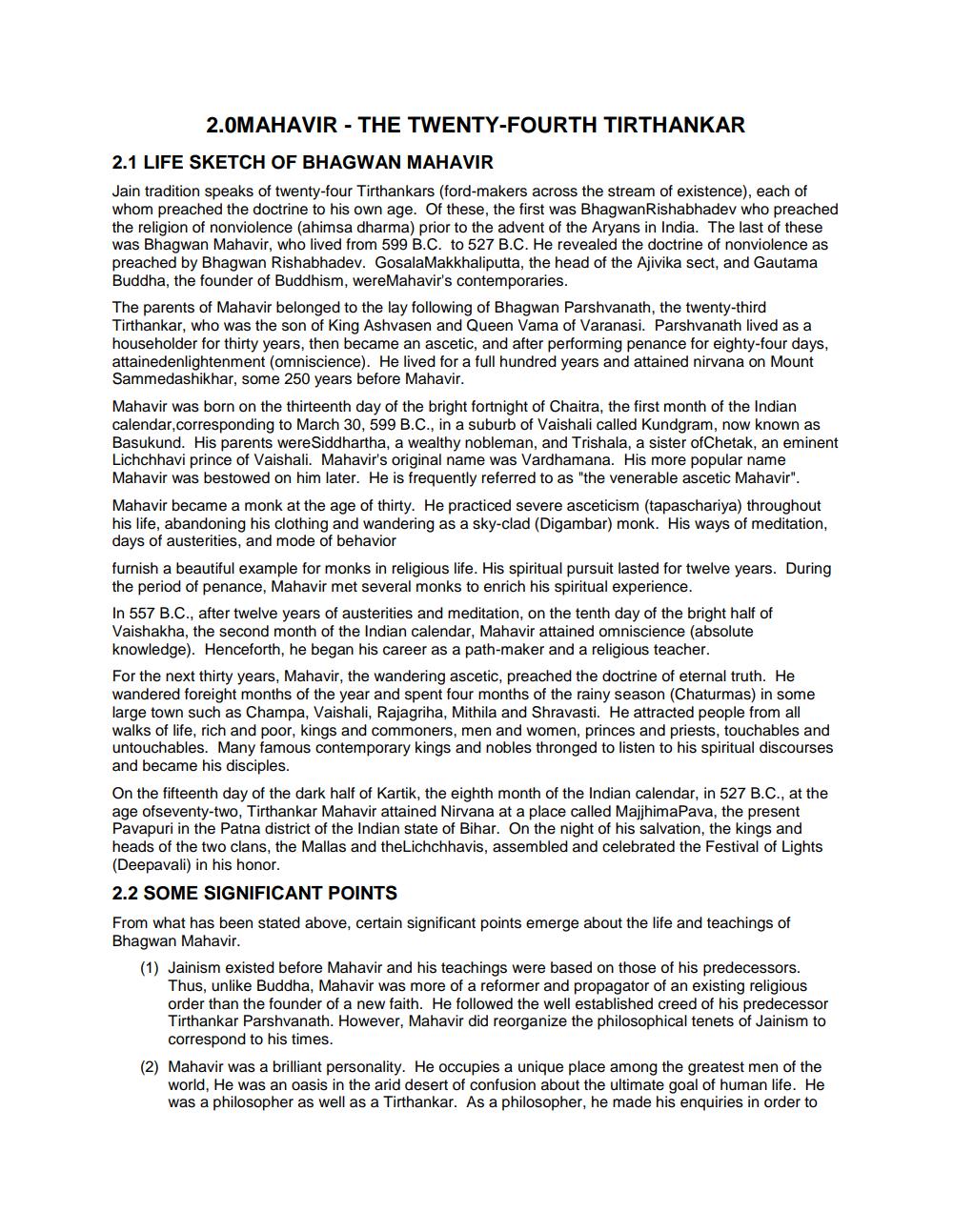________________
2.OMAHAVIR - THE TWENTY-FOURTH TIRTHANKAR
2.1 LIFE SKETCH OF BHAGWAN MAHAVIR Jain tradition speaks of twenty-four Tirthankars (ford-makers across the stream of existence), each of whom preached the doctrine to his own age. Of these, the first was BhagwanRishabhadev who preached the religion of nonviolence (ahimsa dharma) prior to the advent of the Aryans in India. The last of these was Bhagwan Mahavir, who lived from 599 B.C. to 527 B.C. He revealed the doctrine of nonviolence as preached by Bhagwan Rishabhadev. GosalaMakkhaliputta, the head of the Ajivika sect, and Gautama Buddha, the founder of Buddhism, were Mahavir's contemporaries. The parents of Mahavir belonged to the lay following of Bhagwan Parshvanath, the twenty-third Tirthankar, who was the son of King Ashvasen and Queen Vama of Varanasi. Parshvanath lived as a householder for thirty years, then became an ascetic, and after performing penance for eighty-four days, attainedenlightenment (omniscience). He lived for a full hundred years and attained nirvana on Mount Sammedashikhar, some 250 years before Mahavir. Mahavir was born on the thirteenth day of the bright fortnight of Chaitra, the first month of the Indian calendar, corresponding to March 30, 599 B.C., in a suburb of Vaishali called Kundgram, now known as Basukund. His parents were Siddhartha, a wealthy nobleman, and Trishala, a sister of Chetak, an eminent Lichchhavi prince of Vaishali. Mahavir's original name was Vardhamana. His more popular name Mahavir was bestowed on him later. He is frequently referred to as "the venerable ascetic Mahavir". Mahavir became a monk at the age of thirty. He practiced severe asceticism (tapaschariya) throughout his life, abandoning his clothing and wandering as a sky-clad (Digambar) monk. His ways of meditation, days of austerities, and mode of behavior
furnish a beautiful example for monks in religious life. His spiritual pursuit lasted for twelve years. During the period of penance, Mahavir met several monks to enrich his spiritual experience. In 557 B.C., after twelve years of austerities and meditation, on the tenth day of the bright half of Vaishakha, the second month of the Indian calendar, Mahavir attained omniscience (absolute knowledge). Henceforth, he began his career as a path-maker and a religious teacher. For the next thirty years, Mahavir, the wandering ascetic, preached the doctrine of eternal truth. He wandered foreight months of the year and spent four months of the rainy season (Chaturmas) in some large town such as Champa, Vaishali, Rajagriha, Mithila and Shravasti. He attracted people from all walks of life, rich and poor, kings and commoners, men and women, princes and priests, touchables and untouchables. Many famous contemporary kings and nobles thronged to listen to his spiritual discourses and became his disciples. On the fifteenth day of the dark half of Kartik, the eighth month of the Indian calendar, in 527 B.C., at the age ofseventy-two, Tirthankar Mahavir attained Nirvana at a place called MajjhimaPava, the present Pavapuri in the Patna district of the Indian state of Bihar. On the night of his salvation, the kings and heads of the two clans, the Mallas and the Lichchhavis, assembled and celebrated the Festival of Lights (Deepavali) in his honor. 2.2 SOME SIGNIFICANT POINTS From what has been stated above, certain significant points emerge about the life and teachings of Bhagwan Mahavir. (1) Jainism existed before Mahavir and his teachings were based on those of his predecessors.
Thus, unlike Buddha, Mahavir was more of a reformer and propagator of an existing religious order than the founder of a new faith. He followed the well established creed of his predecessor Tirthankar Parshvanath. However, Mahavir did reorganize the philosophical tenets of Jainism to correspond to his times.
(2) Mahavir was a brilliant personality. He occupies a unique place among the greatest men of the
world, He was an oasis in the arid desert of confusion about the ultimate goal of human life. He was a philosopher as well as a Tirthankar. As a philosopher, he made his enquiries in order to




